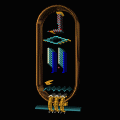-
Posts
369 -
Joined
-
Last visited
Reputation Activity
-
 ShredBird reacted to Stahlmann in Why Does Samsung Keep Sponsoring Me? – Odyssey OLED G8
ShredBird reacted to Stahlmann in Why Does Samsung Keep Sponsoring Me? – Odyssey OLED G8
Please stop speading the misinformation that you need FreeSync Premium Pro or G-Sync Ultimate to use VRR and HDR at the same time. This hasn't been true for a long time now. Any standard FreeSync display that also supports HDR will be able to do both at the same time. If you really run into a case where you can't do both, then it's a software limitation on the monitor side of things, which is a whole other can of worms on a monitor that costs over $1000 USD.
Every HDR supporting monitor i've owned so far supported HDR and VRR simultaneously. Here are a few examples and their respective VRR certification tiers:
LG 27GP950-B - FreeSync / G-Sync compatible
Samsung Odyssey G7 (1440p model) - FreeSync / G-Sync compatible
Asus PG35VQ - (FreeSync support not official, but works) / G-Sync Ultimate
LG C9 OLED - FreeSync / G-Sync compatible
LG C2 OLED - FreeSync Premium / G-Sync compatible
Notice how according to the certification tiers the only monitor that should technically support VRR + HDR is the Asus PG35VQ? In reality it works on all of them. And yes, Doom: Eternal ran in HDR + VRR on all of these monitors. If you really ran into that problem, it's not because of the game not supporting a specific tier of one of the main two VRR standards.
Thank you for reading through my rant about misinformation and/or misleading advertising.
-
 ShredBird got a reaction from jordanb450 in PS5 and Xbox Series X's effect on PC gaming
ShredBird got a reaction from jordanb450 in PS5 and Xbox Series X's effect on PC gaming
This is a good question. During the Digital Foundry deep dive on Xbox Series X they talked about using the SSD as another level of cache for the game, this enables some truly amazing things:
Consider this, in a lot of current games, when a level is loaded, as many assets as are needed are loaded into VRAM for that level. Let's say you have an 8 GB graphics card. The level assets might fill up all 8 GB of that. But when you're in a single room or portion of the level, to render what's in front of you might be using less than 20% of what's stored in memory. By having a fast SSD act as another cache, a developer could potentially use the entire 8 GB of VRAM on a single room of the level knowing they can stream in new assets fast enough to not interrupt the flow of the game.
Asset streaming is not new, in fact it was pioneered with Crash Bandicoot on the PlayStation 1 to overcome the memory limitations there. Huge open world games like GTA V make major use of it, but take into account that people will be using HDDs and that speeds may be slow. Because of this assets are slowly streamed out of a major pool of assets representative of a large portion of the game.
With SSDs a full 8GB of VRAM could be swapped in and out in a matter of seconds loading new assets for the corner you just turned in the game. The amount of detail you can achieve on a per scene basis without increasing the VRAM requirement is staggering.
With the Senua's Sword trailer, Digital Foundry questioned how the game footage seemed to be rendering such high fidelity textures and models per scene. SSD caching may be what's enabling this and it may be a requirement for certain next gen experiences.
I think DX12 Ultimate that Microsoft announced is going to make it so that the advanced graphics features and perhaps storage features can be realized on PC. The question is how much effort will developer put in to adapt their game engines to PCs that are not on the bleeding edge.
Another thing to consider, is, given the highly backwards compatible nature of the new consoles, developers will probably still want to reach those markets too and will have to adapt their engines to run on less powerful hardware anyway.
A lot to digest, but I am excited. Usually console technology holds back what developers are willing to invest money on and this generation really stands out from the last as actually being cutting edge.
-
 ShredBird got a reaction from jones177 in PS5 and Xbox Series X's effect on PC gaming
ShredBird got a reaction from jones177 in PS5 and Xbox Series X's effect on PC gaming
This is a good question. During the Digital Foundry deep dive on Xbox Series X they talked about using the SSD as another level of cache for the game, this enables some truly amazing things:
Consider this, in a lot of current games, when a level is loaded, as many assets as are needed are loaded into VRAM for that level. Let's say you have an 8 GB graphics card. The level assets might fill up all 8 GB of that. But when you're in a single room or portion of the level, to render what's in front of you might be using less than 20% of what's stored in memory. By having a fast SSD act as another cache, a developer could potentially use the entire 8 GB of VRAM on a single room of the level knowing they can stream in new assets fast enough to not interrupt the flow of the game.
Asset streaming is not new, in fact it was pioneered with Crash Bandicoot on the PlayStation 1 to overcome the memory limitations there. Huge open world games like GTA V make major use of it, but take into account that people will be using HDDs and that speeds may be slow. Because of this assets are slowly streamed out of a major pool of assets representative of a large portion of the game.
With SSDs a full 8GB of VRAM could be swapped in and out in a matter of seconds loading new assets for the corner you just turned in the game. The amount of detail you can achieve on a per scene basis without increasing the VRAM requirement is staggering.
With the Senua's Sword trailer, Digital Foundry questioned how the game footage seemed to be rendering such high fidelity textures and models per scene. SSD caching may be what's enabling this and it may be a requirement for certain next gen experiences.
I think DX12 Ultimate that Microsoft announced is going to make it so that the advanced graphics features and perhaps storage features can be realized on PC. The question is how much effort will developer put in to adapt their game engines to PCs that are not on the bleeding edge.
Another thing to consider, is, given the highly backwards compatible nature of the new consoles, developers will probably still want to reach those markets too and will have to adapt their engines to run on less powerful hardware anyway.
A lot to digest, but I am excited. Usually console technology holds back what developers are willing to invest money on and this generation really stands out from the last as actually being cutting edge.
-
 ShredBird got a reaction from KenjiS9965 in DOOM ETERNAL
ShredBird got a reaction from KenjiS9965 in DOOM ETERNAL
Who's playing and what do you think?
I'm loving it so far, looks great in 4K and HDR. The mechanics are brilliant and it's a punishing challenge! I do think this game is harder than DOOM 2016. I beat DOOM 2016 on Nightmare and that was pretty rough for me and this one feels like you hit that level of challenge much sooner.
-
 ShredBird got a reaction from Constantin in DOOM ETERNAL
ShredBird got a reaction from Constantin in DOOM ETERNAL
Who's playing and what do you think?
I'm loving it so far, looks great in 4K and HDR. The mechanics are brilliant and it's a punishing challenge! I do think this game is harder than DOOM 2016. I beat DOOM 2016 on Nightmare and that was pretty rough for me and this one feels like you hit that level of challenge much sooner.
-
.png) ShredBird reacted to LienusLateTips in Selecting a new PSU
ShredBird reacted to LienusLateTips in Selecting a new PSU
SeaSonic does make quite a lot of garbopower units.
-
.png) ShredBird reacted to seon123 in Selecting a new PSU
ShredBird reacted to seon123 in Selecting a new PSU
It's not a particularly good PSU, and you should probably have gone for a nicer PSU, but it should be fine.
The old GD was very similar to the GQ, but the 2019 version is different.
http://www.jonnyguru.com/forums/showthread.php?16906-EVGA-new-GD-series
That's a nice way to possibly get a crappy overpriced PSU. Seasonic makes crap, just like all other companies.
You'd also end up with a whole bunch of PSUs
-
 ShredBird got a reaction from Cyberspirit in Building a satellite
ShredBird got a reaction from Cyberspirit in Building a satellite
Some tips/observations right off the bat from what I've read:
1. Have a well defined mission. You want to measure XYZ using sensors ABC and the mission will last N months.
2. Start defining budgets based on that mission:
Mass Budget: 1U Cubesats generally have to fit within a certain mass range to be eligible for launch. Most of this will be the shell of the satellite, the instruments will likely be a very small percentage of the mass. Cubesats are also required to have their center of mass reside within a certain volume within the Cubesat. Power Budget: You will need a battery, your microprocessor will need steady power from a switching regulator that will need a reliable supply of charge, solar panels alone will not give you a reliable experience. You will have to calculate how much power your cells produce during an orbit to make sure your batteries are happy and make sure you have enough power to run your experiments during an orbit. You must budget power to all your instruments. Telemetry Budget: How much data are my instruments collecting? How much energy/time do I want to use to send that data. This will help you define your power budget and how to design your antenna system. 3. Deployable instruments/equipment are extremely difficult to get cleared for launches. For NASA, they require that you prove that for any moving parts that if that part were completely missing, nothing potentially damaging could occur. Debris in orbit is a huge hazard for real multi-million dollar missions and they're not going to let a little Cubesat mess that up.
4. Start paying attention to the different materials you are planning on using. Your Cubesat will have to pass "shake and bake", that is it must survive the harsh vibrations of a rocket launch, extreme temperature fluctuations and the vacuum environment. For example, no lead solder as lead will sublimate in a vacuum. Certain plastics also out gas and can degrade in vacuum.
5. Have fun! Whether this makes it to space or not, building satellites is one of the most challenging multi-faceted problems an engineer can attempt and if your goal is to be a better engineer than before, you will undoubtedly learn a ton of new things going down this path.
-
 ShredBird got a reaction from Levent in TIL Asoos or Ace-us?
ShredBird got a reaction from Levent in TIL Asoos or Ace-us?
If it's derive from Pegasus then I can see how it can get pronounced a bunch of different ways by English speakers that is most certainly different from a Greek pronunciation. This reminds me of people debating how to say the aircraft manufacturer Embraer, which is just shorthand for "Empresa Brasileira de Aeronáutica". Most people say "em-brayer" but if you read it phonetically from what it would be more like "em-bra-er" where the r's have a single rolled sound and sound more like a softened d.
-
 ShredBird got a reaction from Shrope in Building a satellite
ShredBird got a reaction from Shrope in Building a satellite
Some tips/observations right off the bat from what I've read:
1. Have a well defined mission. You want to measure XYZ using sensors ABC and the mission will last N months.
2. Start defining budgets based on that mission:
Mass Budget: 1U Cubesats generally have to fit within a certain mass range to be eligible for launch. Most of this will be the shell of the satellite, the instruments will likely be a very small percentage of the mass. Cubesats are also required to have their center of mass reside within a certain volume within the Cubesat. Power Budget: You will need a battery, your microprocessor will need steady power from a switching regulator that will need a reliable supply of charge, solar panels alone will not give you a reliable experience. You will have to calculate how much power your cells produce during an orbit to make sure your batteries are happy and make sure you have enough power to run your experiments during an orbit. You must budget power to all your instruments. Telemetry Budget: How much data are my instruments collecting? How much energy/time do I want to use to send that data. This will help you define your power budget and how to design your antenna system. 3. Deployable instruments/equipment are extremely difficult to get cleared for launches. For NASA, they require that you prove that for any moving parts that if that part were completely missing, nothing potentially damaging could occur. Debris in orbit is a huge hazard for real multi-million dollar missions and they're not going to let a little Cubesat mess that up.
4. Start paying attention to the different materials you are planning on using. Your Cubesat will have to pass "shake and bake", that is it must survive the harsh vibrations of a rocket launch, extreme temperature fluctuations and the vacuum environment. For example, no lead solder as lead will sublimate in a vacuum. Certain plastics also out gas and can degrade in vacuum.
5. Have fun! Whether this makes it to space or not, building satellites is one of the most challenging multi-faceted problems an engineer can attempt and if your goal is to be a better engineer than before, you will undoubtedly learn a ton of new things going down this path.
-
 ShredBird got a reaction from Results45 in The Ultrabook with Wicked Graphics - Blade Stealth GTX
ShredBird got a reaction from Results45 in The Ultrabook with Wicked Graphics - Blade Stealth GTX
I've had the new Razer Blade 13 GTX model for about a month now. I also use the left shift key exclusively so that really doesn't affect me. I also don't rest my palms on the laptop when typing,. I also haven't had any trouble with the smaller backspace key I generally leave them floating so the sharp edge doesn't really bother me either.
As for the turbo clocks., it really depends on the load. If it's something that uses a lot of AVX then Intel turbos are kind of weird, but I've definitely thrown some engineering applications at it and it maintains 3.00 GHz all core boost at 100% load. If I go into device manager and disable the GTX 1650, I can maintain a 3.50 GHz all-core boost. I think the firmware reverts to 25 W if it thinks the dedicated GPU isn't present. This works perfect for me, if I know I need to leave my laptop to do a CPU heavy export it's not a big deal to open up device manager and get a little more juice.
Really where this laptop shines is portability. You can get a lot more bang for your buck in terms of spec elsewhere (see @Results45 post), but if you travel a lot like me and really prefer a portable form factor and want to do some decent gaming on the go, it's hard to beat.
Weirdly, also really like Dolby Atmos on these speakers. The frequency response of these speakers isn't spectacular or anything but it does really widen up the sense of space and eerily does have a convincing surround effect at times.
-
 ShredBird got a reaction from Dimzgaming in Is this a good price for this laptop
ShredBird got a reaction from Dimzgaming in Is this a good price for this laptop
You'd be better off getting a new laptop with a Ryzen 3500U. They can be had for about $500, you'll get a quad-core processor, DDR4 RAM, an SSD and Vega 8 graphics will be much faster than 920MX.
-
 ShredBird got a reaction from DarK_FirefoX in Laptop Recommendation i7-1065g7 (coding)
ShredBird got a reaction from DarK_FirefoX in Laptop Recommendation i7-1065g7 (coding)
I just picked up the new Razer Blade Stealth 13 with the i7-1065G7. It's been a good chipset for my needs, especially when coupled with fast RAM and an SSD. I run a lot of engineering programs and I do run VSCode and MATLAB for coding purposes. It's plenty fast for all of those purposes so far. You may get more use from one of Intel's Comet Lake processors with 6-cores if you know you'll be doing heavy multithreading. But as a quad-core it's a great chip. Iris is pretty speedy, much better than any other integrated chip I've used and so far it's been adequate.
-
 ShredBird reacted to bob345 in Show Off your PCB Projects
ShredBird reacted to bob345 in Show Off your PCB Projects
The connectors used are 2.92mm connectors. A bit over kill for this, but i have a bunch of them and they are solder less so why not. the L's and C's you see are really only there as bias tees as this mixer has a built in LO amplifier and if amplifier. Nothing too crazy going on, just breaking out the chip really. And yes, the board is quite small. here are a few images. Mixer is in a 4x4mm qfn and the small passives are 0402'. Mixer is good for 2-7.5ghz
-
 ShredBird reacted to bob345 in Show Off your PCB Projects
ShredBird reacted to bob345 in Show Off your PCB Projects
Like the title says, I think it would be nice to see some printed circuit board projects others may be working on that they are willing to share as there seem to be a good amount of people here that are really into electrical engineering. Anything from hand soldered perf-board projects to full blown PCB assemblies would be great to see here!
Here's a small test board i recently put together for a larger project. This board is for verification of a mixer that will likely be used in a wide band down converter for one of the stages. Being well into microwave territory, every detail of the pcb and layout can effect performance which is why microwave board layouts tend to look so different than conventional layout. Layout was done using kicad 5.0 and simulated with a combination of QUCS and Sonnet
-
 ShredBird got a reaction from Hi P in Programming - GPU intensive things?
ShredBird got a reaction from Hi P in Programming - GPU intensive things?
Basically, if you have large datasets and the operations you need to perform on them can be expressed in terms of linear algebra / matrix operations. For example, in machine learning and optimization problems you are often solving for the inverse of a matrix or matrices, GPUs are very good for this. Also in signal processing where many many fast fourier transforms and other transforms are being performed, this is very useful in real-time feedback control or computer vision. Astronomy that needs to be heavily processed also benefits from GPUs generally.
Another good example is something call FDTD (Finite Difference Time Domain) and FEA (Finite Element Analysis) type codes also benefit from having the parellelism that GPUs offer.
-
 ShredBird got a reaction from Hackentosher in Source for hobby electronics components?
ShredBird got a reaction from Hackentosher in Source for hobby electronics components?
Aside from the websites that have been mentioned, check out the following:
https://www.sparkfun.com/
https://www.pololu.com/
These websites are definitely geared more toward a hobbyist than say a place like Digikey where you already know what parts you're after. They specialize in modularized circuits that can be strung together and kits rather than single parts. I checked their shipping policies and it looks like they ship internationally.
-
 ShredBird got a reaction from Ben17 in My first PCB
ShredBird got a reaction from Ben17 in My first PCB
A bit of constructive criticism here. thicken up your traces, especially where you will be delivering power and along your grounds. I mean, your circuit is simple enough this design should be fine, but it's a good habit to start getting into.
Once you get the hang of that, try pouring copper power planes for power and ground in separate layers.
Good job for your first, go, have fun!
-
 ShredBird got a reaction from Faisal A in My first PCB
ShredBird got a reaction from Faisal A in My first PCB
A bit of constructive criticism here. thicken up your traces, especially where you will be delivering power and along your grounds. I mean, your circuit is simple enough this design should be fine, but it's a good habit to start getting into.
Once you get the hang of that, try pouring copper power planes for power and ground in separate layers.
Good job for your first, go, have fun!
-
 ShredBird got a reaction from Red :) in lead in g-fuel!? :o
ShredBird got a reaction from Red :) in lead in g-fuel!? :o
You should be more concerned with the insane amount of vitamin B G-fuel contains. It can have pretty bad side effects on your organs in that quantity. I always argue for people to get their caffeine from more natural sources like coffee or tea. These energy drinks don't give you anything but a buzz. Eat better food, drink ample amounts of water get more exercise, be moderate with your caffeine intake.
-
 ShredBird got a reaction from Turtle Rig in Will we ever see Motion Rate in PC monitors
ShredBird got a reaction from Turtle Rig in Will we ever see Motion Rate in PC monitors
Honestly, I think there would be a market for something similar implemented on the GPU side of things as a way to fill in interpolated frames when the framerate dips below a certain threshold, when the time to interpolate (or maybe even extrapolate!) frames is shorter than the time to draw a new one. Using machine learning, I think we will start to see a lot of computationally advantageous shortcuts to image quality. Nvidia's DLSS is just the tip of the iceberg.
If I'm not mistaken, Oculus Rift uses some sort of a low framerate compensation mode for underpowered hardware which basically guesses an intermediate frame to keep the scene appearing fluid to the user.
-
 ShredBird got a reaction from Rawrso in DELL S2417DG/S2716DG Banding Fix? Sort of...Enabling Dithering
ShredBird got a reaction from Rawrso in DELL S2417DG/S2716DG Banding Fix? Sort of...Enabling Dithering
1809 OS Build 17763.316
Nvidia Driver: 418.81
Had to make sure the key was set in both places to get it to work. Looking at the gradient test at lagom.nl is has improved drastically. I'm going to recalibrate my display with my colorimeter, I'll probably get much better gamma now.
-
 ShredBird reacted to Rawrso in DELL S2417DG/S2716DG Banding Fix? Sort of...Enabling Dithering
ShredBird reacted to Rawrso in DELL S2417DG/S2716DG Banding Fix? Sort of...Enabling Dithering
In the original post I linked (I might just have to do a "Write up" for here so its less confusing) it shows how to modify the registry file to enable dithering on GeForce drivers. Guzz gives a bunch of dithering options he found. 8 bit temporal was one I and others used with success I tried 10 bit and it didn't seem to work. It might not be as bad on the S2716DG, my buddy has one and his didn't look near as bad as mine when I had him compare what I found so its probably more the S2417DG. For me I just do gaming, and it was horrible and super pronounced.
-
 ShredBird got a reaction from Derkoli in Help! Trying to use 5.1 PC speakers with my TV
ShredBird got a reaction from Derkoli in Help! Trying to use 5.1 PC speakers with my TV
@Kdog If i'm interpreting the use of that adapter correctly, it doesn't actually let you use surround sound, it just provides stereo expansion to a 5.1, which may let OP use the speakers, but not as a 5.1. Plus he said his TV is only TOSLINK or HDMI out.
OP: I don't think there are any simple solutions to what you want to do unfortunately. Things aren't always perfect with TOSLINK either due to most content these days relying on HDCP, and HDMI with an audio return channel (ARC) is kind of the name of the game for receivers.
-
 ShredBird got a reaction from Kdog in Help! Trying to use 5.1 PC speakers with my TV
ShredBird got a reaction from Kdog in Help! Trying to use 5.1 PC speakers with my TV
So a 1/8" to RCA to the adapter you showed and OP can at least get fuller sound if not surround. Probably a similar experience to a soundbar for cheaper!


















